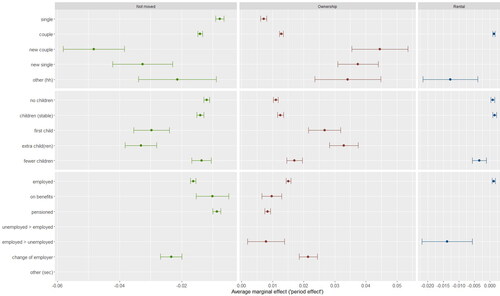Figures & data
Figure 1. Average marginal effects of period (2012–2014 versus 2014–2016) on residential mobility outcomes in relation to partnership, children and employment status, based on model 2. Only significant AMEs are shown with 95% confidence intervals (N = 1,394,636).
Source: SSD, Statistics Netherlands, own calculations.

Table 1. Probability of a move by life course (partnership, children and employment) and period: marginal effects of period and differences in period effects across three household variables (N = 1,394,636).
Figure 2. Relative average marginal effects of period (AME divided by estimate for period 2012–2014) on two mobility outcomes in relation to partnership, children and employment status, based on model 2. Only significant AMEs are shown (N = 1,394,636).
Source: SSD, Statistics Netherlands, own calculations.

Table 2. Mobility of owners in two periods (2012–2014 and 2014–2016).
Table 3. Probability of a move in t0-t2 by life course (partnership, children and employment) in t-2-t0 and t0-t2 and period of owners who did not move in the preceding two years: marginal effects of period and differences in period effects across three household variables (N = 1,281,961).
